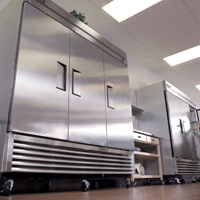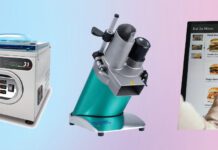It’s no secret that purchasing refrigeration and ice-making equipment doesn’t likely generate too much excitement. In fact, since it can last 10 years or longer, investment decisions are less about the glitz and glamour and more about practicalities.
A&W Food Services of Canada Inc., which is expected to open 35 new restaurants in 2013, is constantly scouting refrigerator styles — from walk-in and reach-in coolers and freezers to smaller under-the-counter drawer units for food staging, says Tyler Pronyk, manager of Equipment Services in Vancouver. And, he notes that, given the utilitarian nature of refrigeration, along with the overall lifespan of the equipment, the key is to find the right supply partner. “Given how much we’re expanding, it’s the supplier and service network that’s the most important consideration, although we do work with specific brands and look at Energy-Star ratings to ensure energy efficiency.”
Scene stealers
But, brand names aside, these days, the machines winning favour are blast chillers and freezers. “They’re becoming a part of everyday kitchen life, from small bistros to large institutions,” says Doug Feltmate, president of Designed Food Systems Inc., foodservice planning and design consultants based in Ottawa. “They’re probably the busiest pieces of equipment being used in kitchens, because they’re good for chilling, freezing, candying; there are so many different uses.”
The equipment can also help operators meet HACCP (hazard analysis and critical control points) cooling requirements. “The only way to achieve true HACCP compliance is with blast chillers,” says Feltmate, explaining that the speed and temperature monitoring help meet food-safety requirements. “In small restaurants, they’re constantly in use, because they can monitor temperature and keep it out of the hazardous zone.”
Control freak
Meanwhile, control systems and sensors that can be integrated with refrigeration systems to save energy are also gaining attention, says Don Fisher, president, Fisher-Nickel, Inc., and manager at the PG&E Food Service Technology Center in San Ramon, Calif. While there seem to be many options being brought to market, operators should do their homework, since some will not deliver the promised return on investment, he advises.
But, “smart defrost” is one control technology that can be effective in reducing energy costs, he notes. “Right now, freezers and coolers are primarily defrosted on a timed basis. These [smart defrost] systems monitor pressure in refrigeration systems to measure if ice is building up on the evaporator coil. It can be a big energy saver, because it avoids over-defrosting.”
Ice fever
On the ice machine side of the counter, equipment is being geared to smaller footprint and higher-production capacity. As far as output is concerned, the industry is trending in two directions, says John Silva, president of The Iceman in Toronto, a provider of ice and ice-making machines. Chewable ice continues to dominate in restaurant groups and chains as a means to increase margins on soft drinks by increasing the amount of ice in a cup, thereby reducing the amount of beverage used. On the more upscale side, mixologists are using bigger cubes that take longer to melt and won’t dilute drinks.
Flakers are also shrinking in size to meet the demands of smaller restaurants. This is a big help to sites such as Hopgoods Foodliner in Toronto, which specializes in sustainable seafood dishes from Atlantic Canada. Recently, Geoff Hopgood, executive chef and owner, invested in an under-the-counter flaker for enhancing its table presentation. “It’s great to have for keeping shellfish chilled at the table and making it look more appealing,” he says. It’s a big improvement over smashing ice cubes with a hammer, he adds. “We just turn the machine on about five or six hours before dinner, and we have enough to last the night.”
Hopgood’s new ITV Flaker IQ 100C unit costs a little more than $2,100 and is reportedly the only one on the market that produces 100 lbs. of ice a day. As Silva reports, before it came to market, an entry-level flaker produced 300 lbs. and started at approximately $3,500, putting it out of reach for smaller venues.
Silva recommends that customers buying a flaker ice machine use a filter. “Because the ice goes through an augur, it builds up on the walls. If water isn’t filtered properly, your flaker might last three to five years. With filters, I’ve seen them go five to 10 [years].” Filters cost $150 to $500, depending on the size of the machine and should be replaced every nine to 12 months.
One improvement in ice-making that appeals to Feltmate is the new digital technologies that enable remote diagnostics. “You can know when there’s any trouble within the compressor ahead of time, so you don’t have a failure. There’s nothing worse for a bar than losing ice on a Friday. You can run a diagnostic on Tuesday to see if there are any problems.”
Erin Gamelin, owner of Stout Irish Pub in Toronto, is working with a prototype system from Manitowoc that features satellite monitoring. “If anything is going wrong in the system, the manufacturer knows,” she explains. The unit replaced an older one that came with the restaurant when she bought it. “There were constantly issues with ice not flowing and blockage. I can’t tell you how many times we had to go out and buy ice midway through service.”
Choosing ice-making equipment can be a challenge, due to the many permutations available, but Fisher points out that AHRI (Air-Conditioning, Heating & Refrigeration Institute) maintains a database on performance metrics for all ice machines sold. “If you’re interested in selecting a machine that uses the least amount of energy and water, that data exists. That’s not the case for all appliances.”
Design solutions
Once the equipment is purchased, consider the kitchen layout. “People have to start thinking about refrigeration differently,” Feltmate says. “When it comes to a walk-in especially, you should be looking beyond energy-efficiency to consider it in light of a real-estate play. If less aisle space is being used for walk-in refrigeration, for example, you might have enough room for 10 more customers.”
He notes that the real-estate costs are surprising once you consider that walk-ins are 65-per-cent air. Case in point: Feltmate conducted a study at a restaurant that found aisle space in walk-ins was costing the operation $6,000 a year based on a $30-per-square-foot lease rate. “Nobody looks at it in those terms, but those are real numbers. Factor in those aisles over the lifespan of the box, and it could be worth more than the equipment itself.”
Feltmate suggests solving this problem by using a European-inspired linear layout of reach-ins and roll-ins to allow more flexibility and optimize floor space. Not only do the refrigerators take up less room, they can easily be unplugged if they’re not needed. With roll-ins in the lineup, operators can also roll shelving units in and out, a bonus for operations that need a prep cooler for racking products prior to large events.
In the end, choosing the best refigeration and ice-making equipment for an operation is about maintaining the bottom line, and that often means making practical choices.
Keep Reading
F&H Highlights Products From the 2013 NAFEM Show
Misunderstood: Microwaves in Foodservice
CRFA Launches Specialized Insurance Program for Foodservice Establishments





















